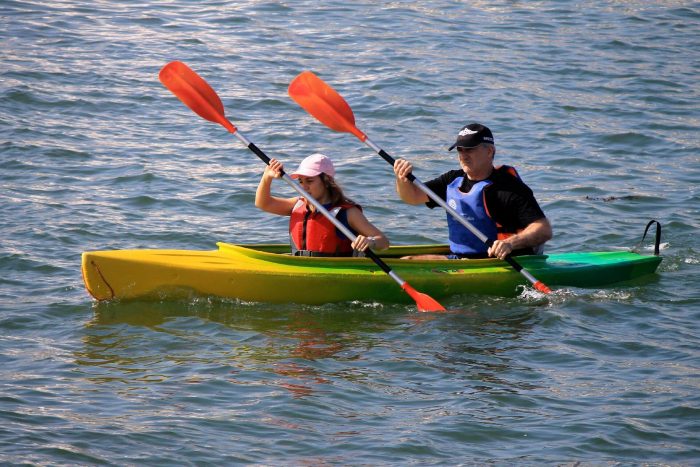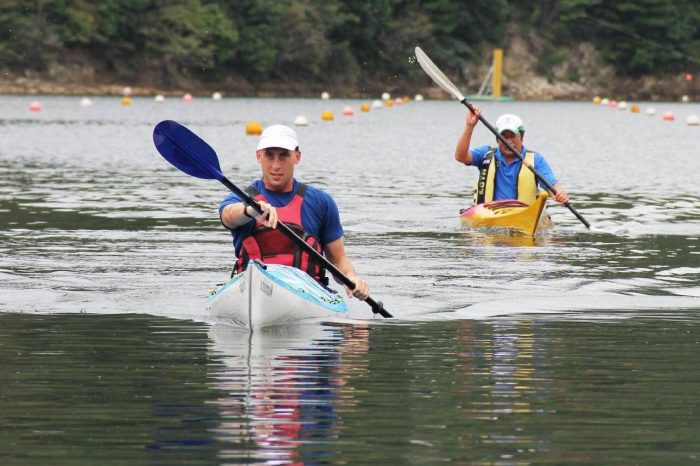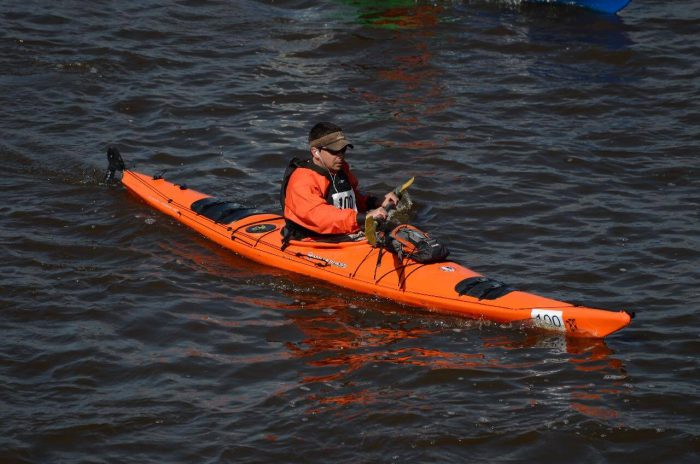The kayak speed for an experienced paddler can easily reach speeds of around 8 mph while a novice might only be able to go about 3 mph. Recreational kayakers typically reach speeds of 3 knots or more, which is considered as the average kayak speed.
Key Takeaways
- Various factors significantly affect the speed of a kayak like weather conditions, the strength of the paddler, the type of kayak, the paddle, etc.
- The longer and narrower the kayak you choose to travel, the more speed you will be able to gain
- Kayaking helps you a lot in enhancing your muscles in the chest, arms, shoulders, and back
- You can modify the equipment you have for kayaking to increase the speed with convenience

What Is The Average Speed Of A Beginner Kayaking?
Beginners can usually kayak at a speed of two to four kilometers every hour. However, there are some other factors that bring fluctuation in rate, such as load. If your kayak has a light load, then you can move faster or vice-versa.
What Is The Function Of Vessels In A Kayak?
A kayak has an enclosed vessel, and you need to sit inside, extending your legs towards the front side. So, the longer and narrower the kayak you choose to travel, the faster you can reach the destination.
Does Kayaking Have Any Health Benefits?

Kayaking is a low-impact activity and is perfect for exercising, especially for those who cannot perform a strenuous workout routine. Kayaking is great for improving your cardiovascular system. Plus, they help you a lot in enhancing your muscles on the chest, arms, shoulders, and back.
Since it is a type of low-impact activity, it puts less anxiety on your tissues and joints. Therefore, regular kayaking can boost their legs and torso strength while operating the vessel by rotating it with leg pressure.
How Can I Improve My Kayak Speed?
You must follow some essential steps if you want to increase your kayak speed. Remember, you are the engine of your kayak, so, the first thing you need to do is increase your strength and stamina. With this, refine your technique of paddling. The more refined it becomes, the more it will help to increase your kayak speed.
Apart from working on yourself, you can modify the equipment you have for kayaking (i.e Kayak sails). Choose a lightweight swinging paddle. This will allow you to manage the speed with convenience.
You can go for a longer and narrower kayak, for it will minimize the friction and resist waves and let you track faster.
In What Way Does The Wave Resistance Influence The Speed Of The Kayak?

When a kayak moves on the water bodies, it creates two patterns of waves. One is the wave fan that takes from the kayak bow itself known as the divergent wave. This form of wave impacts the nominal on the kayak.
Next is the transverse wave, which emerges in the direction of the right-angle side to which the kayak is moving. The transverse waves convey to you the energy lost throughout the function of bow water striding from the way and suctioning back again.
So, when your kayak wave resistance is high, the possible speed of it goes down. It is worth noting that the wave resistance can have an impact on the kayakers moving above the speed of four knots.
What Are The Major Characteristics Of Kayaks That Determine The Wave Resistance?
Well, there are varied types of kayaks, and each has its own unique traits such as waterline length, waterline beam, displacement, bow shape, stern, etc., that can determine the wave resistance of the kayaks.
What Are The Ways Of Improving Paddling Technique For Faster Kayaking?
The use of the right technique for paddling can improve the kayaking speed without owning much pressure. So, firstly analyze the numbers of horsepower and speed. If your aim is to track at an average rate of 3.5 mph (three knots), then your body needs to develop nearly 0.02 to 0.03hp.
This is the effort a fit human generally puts in for walking. But, if you want to higher your speed to five to six knots, then generate nearly 0.1hp to 0.2hp.
Some Other Essential Techniques You Can Follow To Improve Your Paddle Techniques Are-
1. Maintain the right position of your body. First, sit in the given seat and then position straight with your feet balls pressing against the braces or pegs firmly. Now check whether the adjustment of your seat is comfortable for paddling or not. If not, please make the necessary adjustments.
2. After following the above instructions, bend the knees in the shape of a diamond and press the thighs next to the thigh braces when paddling in a sit-in kayak. But if you are on a sit-on-the-top kayak, then press your thighs opposite to the kayak itself.
3. Sitting in the right position will let your upper torso with optimal mobility and lower the chances of a shoulder injury. Besides, it will also broaden the contact points with the kayak and consequently give better control.
4. Always use both the strength of your arms and other big muscles to minimize the chance of rapid fatigue. Additionally, keep the Paddler’s Box in mind. It is an abstract box that you create to hold the paddle and your hands in the front of the torso. While stroking the paddle, revolve the torso in such a way that it keeps the box intact. Apply this technique to maintain the shoulders inside the sockets.
5. Try to pull and push your paddle instead of just pulling it. Pull the lower paddle blade into the water near your toes and stretch your high blade into the air away from your side. This technique helps you to track quickly through the water for a long time without releasing more energy.
6. When you see your low blade coming about the level with your buttocks, promptly twist and raise the paddle away from the water. Simultaneously, plant your front paddle into the water for inciting the Catch to the opposite side of the kayak. But, if you leave the paddle blade in the water for an extended period, it will intensify the drag and automatically lower the speed of your kayak.
7. Hold the paddle in the upright position when the blade is in water. This will ensure the paddle blade stroke near the kayak hull and thus, letting a faster move.
8. Relieve tension from the grip of your paddle. Otherwise, you may develop blisters in your hands, and your forearms feel the exhaustion quickly.
9. Be gentle to enclose the fingers encircling the paddle shaft, and using the thumb, try to safeguard the position. While pulling the low blade in your direction, press the thumb opposite to the paddle shaft. When trying to push the upper blade, use your flat portion of the hand.
Besides These, There Are Some Quick Tips For Efficient Paddling.

1. When you notice your paddle is losing its grip or lacks enough grip, wrap electrical tape around it. It will help to fix the problem quickly.
2. A paddle having a low swing weight is lighter and helps to track faster. So, for increasing the speed of your kayak, invest in a good quality faster paddle. A good quality paddle of carbon fiber will deliver efficacy and comfort while you stroke through the water.
So, enhancing your skills in paddling will upgrade your efficiency in speeding up the kayak. Moreover, this activity will help you build a strong body permitting you to receive better out of each stroke. Your ability to endure will further increase, and let you go for a more vigorous stroke that too for a long time.
Does Friction Leave Impact On The Kayak Speed?
Although a kayak hull looks smooth, still in general, it is rough. So, when the kayak moves through the water, a skinny water layer gets into the trap of this roughness. Then, this trapped water starts to collide with the other water layers that are remaining untrapped.
Subsequently, a chain of reactions arises in the space of the boundary layer, where 99% of the friction emerges. So, when the friction occurs more, the resistance is also higher but lowers the speed of the kayak.
Why Is Hull Shape So Important?
The hull design is critical when buying a kayak. This is mainly because of stability and comfort. The V-shaped hull offers more comfort and stability and also improves tracking through the water.
So, before buying, ask your seller about its stability, including both the primary and secondary since your life depends on its shape.
What Are the Different Types Of Materials That Go Into The Making Of The Kayak?
There are basically three types of materials that go into the making of the kayak. Check out the table to know more about their differences.
| Type Of Material | Pricing | Weight |
| Plastic Polyethene material | They are cheaper. | When made with plastic, the kayak weighs heavily. |
| Fiberglass | These types of materials are available in the mid-priced range. | They are lower in weight than plastic. So, you can find them in the mid-weight. |
| Composite | They are the most expensive material for kayak construction. | The use of composite material makes the kayak lighter weight. |
How Much Does The Kayak Weight Varies?
Generally, you will find the weight of the kayaks varying somewhere between twenty to eighty pounds and sometimes more than that.
The most common type of kayak, however, weighs from thirty-five pounds to sixty pounds. You can check out the models by contacting the sellers to know more about them.
How Much Time Will The Kayak Take To Cover 1 Mile Distance?
On average, the kayak will take around 30 minutes to cover a mile over calm water. However, it depends on the other factors already mentioned above to reach a one-mile distance.
Does Sharks Attack On the Kayaks?
Though it is sporadic, still yes, sharks make an attack on the kayak. Since the beginning of the 1900s, there are records of 21 cases. As a necessary precaution, try to avoid staining the water with blood and stay away from any cloudy mouths of the river and suspicious water during the time of twilight and sunrise.
Also, maintain distance from large fish groups, sea lions, or seals to resist the chances of being misjudged as a meal. If by chance you get to see any shark, refrain from paddling away that time. The splashing of your paddle can attract the attention of the sharks as you may look at them just the same as an injured seal.
Does The Colour Of the Kayak Matter?
Specifically, the color of the kayaks does not make any difference. A vibrant color like orange or yellow can make your kayak visible to other kayakers. So, there lies ultimately your individual safety and nothing else.
Hence, the color of kayaks mainly depends on personal preference. If you want to make yourself noticeable, select lighter and more vibrant colors. If you prefer to stay hidden, then select any dull or darker tone color.
Final Thoughts
Nothing is impossible unless you try them with the right techniques. Follow these definite steps to increase your kayak speed. Kayaking is beneficial for the physical and emotional aspects without putting more strain.
Usually, a faster kayak is longer, lighter, narrower, and sharper. Still, the magic of increasing the speed of your kayak lies in the matching of the kayak hall with the engine, that is you. When you improve the technique of paddling, you will find your kayak is tracking straight at a higher speed and that too for a longer time.
Additionally, it will be the cherry on top if you choose a lighter swing-weight paddle with a smooth, broad, and buoyant blade. This investment will benefit you to push your kayak comfortably to the next gear.
References:
- https://wellenliebe.de/en/how-fast-kayaking/
- https://www.quora.com/What-speed-do-most-recreational-kayakers-travel-at

Rockey is a kayaking enthusiast who has been kayaking with a local group for the last five years. He loves using kayaks while out on outings on the water or camping when the friends want to have a BBQ party somewhere on the bank of a local lake. More About James R Rockey at About Page Here: Authors
Based on his experiences with the different types of kayaks, he is sharing his opinion about kayaking tricks and required gears so that a beginner can get started right away.
Find his team on Twitter here. Happy reading!
